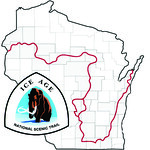As you walk along the trail from Townline Road, you will come to:
- a bench overlooking a kettle pond, (Dumke Lake);
- a sign identifying the area as an ice-walled lake plain; and
- a dry melt-water channel.
A kettle is a depression in the land and is formed when a block of ice breaks away from a receding glacier. The ice then gets buried by glacial outwash. When the ice blocks eventually melt, kettle holes are left behind.

Mickelson, David M.. GEOLOGY OF THE ICE AGE NATIONAL SCENIC TRAIL.. ©2011 by the Board of Regents of the University of Wisconsin System, Reprinted by permission of the University of Wisconsin Press.
/>An ice-walled lake plain forms when the glacier acts as a container to hold water dammed in a complex of debris-covered ice. The lake sediment accumulates with fine-grained sediment carried to the more central, deeper parts of the lake. Course sediment of sand and gravel accumulated around the edge of the lake as it slides off the surrounding ice. The lake sediment stands as a relatively flat-topped hill that is higher than the surrounding area when the ice walls containing the lake have completely melted away.
[Ice-Walled Lake Plain Diagram - ©2011 by the Board of Regents of the University of Wisconsin System, Reprinted by permission of the University of Wisconsin Press.]
Many ice-walled lake plains have a dish-shaped surface with the course material deposited near the ice wall forming a rim ridge around the lake plain. They are commonly roughly circular areas of a mile or more across.
A tunnel channel is formed when a subglacial river cuts into the underlying glacial bed. Eventually, water under high pressure exited and cut a gorge or tunnel channel. In Wisconsin, such channels occur along the outermost edge of the late Wisconsin advance. The water flows that cut tunnel channels were apparently sudden, short-lived, and huge. They carry a large flow of glacial melt-water from beneath the ice creating broad troughs.
 IATCC is the cache designation to highlight a series of EarthCaches along the Ice Age National Scenic Trail grouped into a special category called "ColdCache."
IATCC is the cache designation to highlight a series of EarthCaches along the Ice Age National Scenic Trail grouped into a special category called "ColdCache."
The Ice Age Trail is one of eleven National Scenic Trails designated by the National Park Service. This unique trail is entirely within the state of Wisconsin and follows along the terminal moraine of the most recent glacier which retreated about 10,000 years ago.
This project is supported by the Ice Age Trail Alliance (IATA). The goal is to bring more visitors to the trail and promote public awareness, appreciation, and understanding of Wisconsin’s glacial landscape.
The IATA has created an awards program to encourage visits to the trail and ColdCache sites. This awards program is separate from, and in addition to, any other Geo- or EarthCache awards program.
A current list of approved ColdCache sites can be found on the “IATCC Bookmark List”. More information on the Ice Age Trail Atlas, the Companion Guide, the ColdCache Project and Awards Program can be found on the “ColdCache Webpage”
Permission
The Geocache Notification Form has been submitted to Brenda Rederer of the Wisconsin DNR. Geocaches placed on Wisconsin Department of Natural Resource managed lands require permission by means of a notification form. Please print out a paper copy of the notification form, fill in all required information, then submit it to the land manager. The DNR Notification form and land manager information can be obtained at: www.wi-geocaching.com/hiding
Resources:
Geology of the Ice Age National Scenic Trail; by David M. Mickelson, Louis J. Mahler Jr., and Susan L. Simpson
To claim this find:
Observe the locations of the three features discussed in relation to each other.
1. In what order do you think the kettle, ice-walled lake plain, and tunnel channel were formed? Why?
2. Would an ice-walled lake plain be better or worse for farming than the surrounding area? Why?